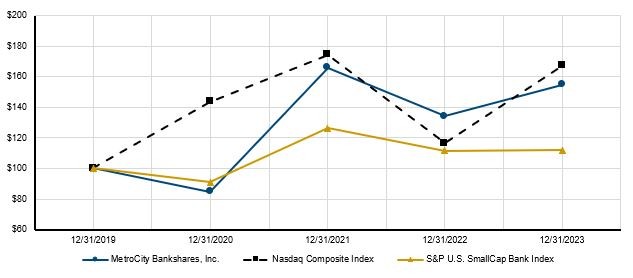to lower underwriting, processing and origination fees earned from our origination of residential mortgage loans as mortgage volume declined during the year ended December 31, 2023 compared to the year ended December 31, 2022. Mortgage loan originations totaled $337.0 million during the year ended December 31, 2023 compared to $833.6 million during the year ended December 31, 2022.
Total gain on sale of loans was $3.3 million for the year ended December 31, 2023 compared to $4.1 million for the year ended December 31, 2022, a decrease of $786,000, or 19.2%.
We recorded no gain on sale of residential mortgage loans during the year ended December 31, 2023 as no residential mortgage loans were sold during the period. Gain on sale of residential loans totaled $2.0 million for the year ended December 31, 2022 as we sold $94.9 million in residential mortgage loans during the period with an average premium of 2.13%.
Gain on sale of SBA loans totaled $3.3 million for the year ended December 31, 2023 compared to $2.1 million for the year ended December 31, 2022. We sold $72.9 million in SBA loans during the year ended December 31, 2023 with average premiums of 6.09% compared to the sale of $31.5 million in SBA loans with an average premium of 8.45% in the year ended Decemer 31, 2022.
Mortgage loan servicing income had an expense balance of $193,000 for the year ended December 31, 2023 compared to an expense balance of $561,000 for the year ended December 31, 2022, an increase of $368,000, or 65.6%. The change in mortgage loan servicing income was primarily due to the decrease in mortgage servicing amortization, offset by decreases in mortgage servicing fees and capitalized mortgage servicing assets. Included in mortgage loan servicing income for the year ended December 31, 2023 was $2.5 million in mortgage servicing fees compared to $3.2 million for 2022, and capitalized mortgage servicing assets of $0 for the year ended December 31, 2023 compared to $761,000 for 2022. These amounts were offset by mortgage loan servicing asset amortization of $2.7 million for the year ended December 31, 2023 compared to $4.7 million for the year ended December 31, 2022. During the year ended December 31, 2023, we did not record a fair value impairment on our mortgage servicing assets. During the year ended December 31, 2022, we recorded a fair value impairment recovery of $163,000. Our total residential mortgage loan servicing portfolio was $443.1 million at December 31, 2023 compared to $526.7 million at December 31, 2022.
SBA servicing income was $4.8 million for the year ended December 31, 2023 compared to $1.8 million for the year ended December 31, 2022, an increase of $3.0 million, or 162.8%. Our total SBA and USDA loan servicing portfolio was $508.0 million as of December 31, 2023 compared to $465.1 million as of December 31, 2023. SBA servicing fees totaled $4.6 million for the year ended December 31, 2023 compared to $5.0 million for the year ended December 31, 2022. Our SBA servicing rights are carried at fair value and inputs used to calculate fair value change from period to period. During the year ended December 31, 2023, we recorded a $201,000 fair value gain on our SBA servicing rights compared to a $3.1 million fair value adjustment charge on our SBA servicing rights during the year ended December 31, 2022.
Other noninterest income was $2.7 million for the year ended December 31, 2023 compared to $1.1 million for the year ended December 31, 2022, an increase of $1.7 million, or 159.0%. The largest component of other noninterest income is the income on bank owned life insurance, which totaled $1.8 million and $1.7 million, respectively, for the years ended December 31, 2023 and 2022. Also included in other noninterest income are fair value gains/losses on our equity securities, which totaled $35,000 (gain) and $1.1 million (loss), respectively, for the years ended December 31, 2023 and 2022.
Year ended December 31, 2022 compared to year ended December 31, 2021
Service charges on deposit accounts were $2.0 million for the year ended December 31, 2022 compared to $1.7 million for the year ended December 31, 2021, an increase of $295,000, or 17.4%. The increase was primarily attributable to increased analysis fees and overdraft fees.
Other service charges, commissions and fees decreased $4.7 million, or 32.6%, to $9.7 million for year ended December 31, 2022 compared to $14.4 million for the year ended December 31, 2021. The decrease is mainly attributable to lower underwriting, processing and origination fees earned from our origination of residential mortgage loans as mortgage volume declined during the year ended December 31, 2022 compared to the year ended December 31, 2021.
